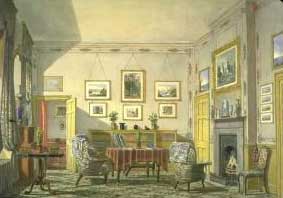Early Victorian Furniture History in England
"the luxury of ease"
In the homes of early Victorian age England in the 19th century we see furniture, for the first time, that was made with concerns about ordinary comfort being the determining factor in its design and making. With a great increase in the numbers of middle class homes and houses more furniture was needed and it was made in an abundance of styles, but again for the first time in history, with the desires of the consumer most to the fore.

Victorian Interior, 1855.
The early Victorian age in England from around 1835 witnessed the decline in popularity of the smooth and relatively simple Grecian style of Regency furniture in the preceding period in history, 1800-1830. It was largely replaced by more serious furniture, more imposing, rounded, with ample ornament, decoration, curving, and gloss. Classical, heavy, styles however did persist in "male" areas such as clubs as well as in the dining room.
The Battle of the Styles

Gothic Revival Table, 1852.
No single style emerged as dominant in the homes of the early Victorians, rather furniture designers, and now manufacturers, drew on, or ransacked, a multitude of styles from earlier periods in history with Gothic, Tudor, Elizabethan, Renaissance, English Rococo, and Neo Classical battling it out for prominence. The Gothic revival style was probably the most "important" in furniture history terms while the exuberant Rococo revival may have taken the honours in the popularity stakes.

Rococo Revival Chair, 1845.
Mahogany and rosewood were the woods of choice with oak making something of a nationalist comeback from the depths of time, admired for its Englishness. Iron also made its appearance in the early Victorian age particularly in Victorian bedroom furniture. Paper mache was also used in Victorian age furniture.

Victorian Paper Mache Chair, 1850.
Victorian Decadence
"it seems to us that the art manufacturers of the whole of Europe are thoroughly demoralized"
So said the "The Times" in 1851 commenting on the furniture and other interior decorations displayed at the Great Exhibition in London, 1851. The furniture exhibited at the Exhibition shows early antique Victorian furniture at its most extravagant and flamboyant and somewhat cut off from reality.

Victorian Armchair, 1851.
By this time, around the middle of the nineteenth century, good design may be said to have suffered in much early Victorian furniture, even in country areas, with the partial exception of chair making. The demands of the mass market, with its concerns of economy, led to a probably inevitable decline in standards of ordinary domestic furniture with lots of showy, hastily and cheaply put on ornament and veneer attempting to conceal the lack of quality craftsmanship.
The seeds of the arts and crafts movement and the art furniture fashion of late Victorian style furniture had been sown.
